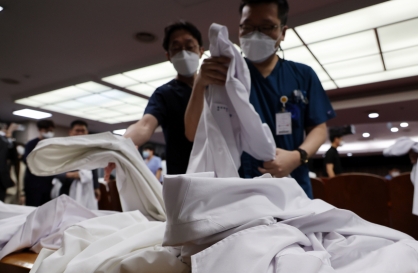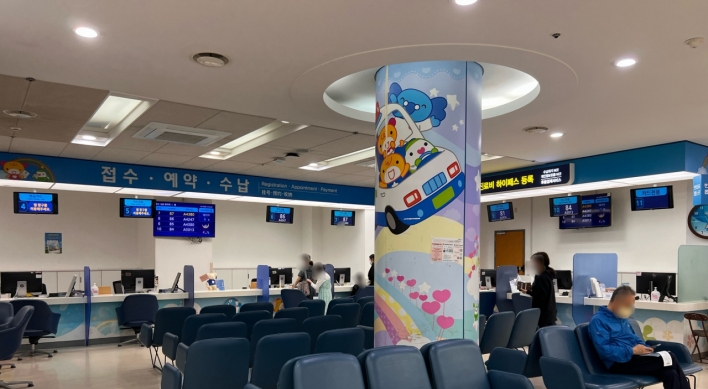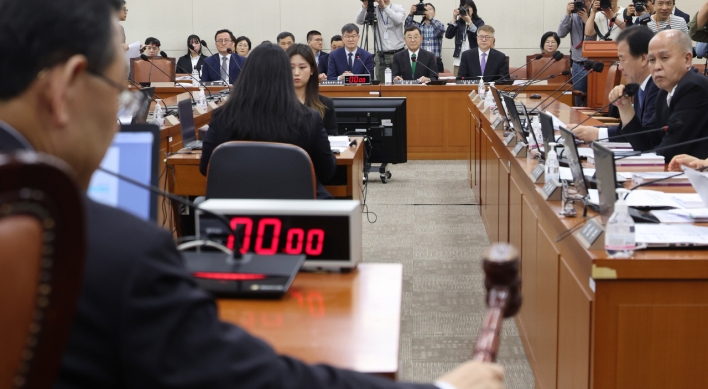Subway screen door boosts cancer-causing substance in cars: research
By Korea HeraldPublished : Sept. 5, 2012 - 09:49
The installation of platform screen doors (PSD) in Seoul’s subway stations resulted in the increased concentration of cancer-causing substance in subway cars, a survey showed Wednesday.
According to the research by the Seoul Institute of Health and Environment, the concentration of radon rose by an average of 53 percent in the city’s subway lines No. 2 through 8 after the safety device between the train and the platform was put in place in 2008.
The comparable figures were measured in 2008 and 2010, according to researchers.
A naturally occurring radioactive gas, radon is known as the second most likely cause of lung cancer in many countries, according to the World Health Organization.
“The PSDs appear to further isolate underground tunnels, from which radon mostly comes, and prevent the substance from dissipating,” a researcher said.
“We’ve also learned that the radon concentration tends to rise further when the country experiences yellow dust in the spring season. It means that the current ventilation system is not enough to filter the air,” he added.
(Yonhap News)
<관련 한글 기사>
스크린도어 발암물질 몇 호선이 가장 위험?
지난 2008년 수도권 지하철 승강장에 스크린도어(PSD)가 설치된 뒤 전동차 내 폐암을 유발하는 물질인 ‘라돈’이 크게 증가한 것으로 나타났다.
5일 한국대기환경학회지에 게재된 서울시보건환경연구원의 ‘수도권 지하철 전동차에서의 라돈 농도 분포 조사’ 논문에 따르면 PSD 설치 후 서울 지하철 2~8호선의 전동차 내 라돈 농도는 평균 53% 증가했다.
자연 방사능의 일종인 라돈은 고농도에서 오랜 기간 노출되면 폐암을 일으키는 것으로 알려졌다.
무색무취의 라돈은 토양과 접한 지하건축물의 실내공간에서 짙은 농도를 나타낸다. 특히 환기상태가 불량한 지하공간에서 오랜 기간 작업하는 근로자 등에게 큰 위해를 준다.
연구원이 PSD 설치 전인 2008년 봄과 설치 후인 2010년 봄에 2~8호선의 전동차 객실 라돈 농도를 측정한 결과 설치 전 농도는 ㎥당 20.1±11.1베크렐(Bq), 설치 후 농도는 30.8±21.7Bq로 나타났다.
연구원 측은 “PSD 설치가 라돈의 주 발생원인 터널을 더 밀폐시켜 승강장과 대합실로 통하는 라돈의 확산 통로를 차단한 것이 농도 증가의 주된 요인으로 추정된다”고 설명했다.
호선 별로는 5호선이 PSD 설치 전 ㎥당 28.86±7.2Bq로 가장 짙은 농도를 나타냈으며, 설치 후에도 76.5±23.9Bq로 166% 늘어 가장 높은 증가율을 보였다.
이어 6호선(설치 후 34.3±9.9Bq/㎥, 증가율 117%), 7호선(32.3±18.1Bq/㎥, 78%), 8호선(19.0±3.8Bq/㎥, 46%), 2호선(15.1±6.3Bq/㎥, 26%) 순으로 증가율을 보였다.
2010년만 측정한 1호선 지하역사와 9호선은 2호선보다 옅은 농도 수치를 나타냈다.
5~8호선에서 농도가 상대적으로 짙게 나타난 원인으로는 라돈이 많이 분포하는 것으로 알려진 화강암 기반의 역사가 많다는 점, 운행구간의 심도가 1~4호선보다 깊어 공기보다 9배 이상 무거운 라돈이 모이기 쉽다는 점 등이 꼽혔다.
황사 발생 시 라돈 농도가 비정상적으로 높아진 것도 관측됐다. 황사가 출현한 2008년 5월30일에 5호선의 라돈 최고농도는 145Bq/㎥, 2009년 3월16일에 3호선은 68.8Bq/㎥, 17일에 7호선은 160.0Bq/㎥를 기록했다.
연구원 측은 “황사 유입을 우려한 비정상적인 환기시스템 가동에서 비롯된 결과로 보인다”며 “기존 환기시스템은 라돈의 증가를 야기할 수 있어 개선이 시급하다”고 설명했다.
(연합뉴스)
According to the research by the Seoul Institute of Health and Environment, the concentration of radon rose by an average of 53 percent in the city’s subway lines No. 2 through 8 after the safety device between the train and the platform was put in place in 2008.
The comparable figures were measured in 2008 and 2010, according to researchers.
A naturally occurring radioactive gas, radon is known as the second most likely cause of lung cancer in many countries, according to the World Health Organization.
“The PSDs appear to further isolate underground tunnels, from which radon mostly comes, and prevent the substance from dissipating,” a researcher said.
“We’ve also learned that the radon concentration tends to rise further when the country experiences yellow dust in the spring season. It means that the current ventilation system is not enough to filter the air,” he added.
(Yonhap News)
<관련 한글 기사>
스크린도어 발암물질 몇 호선이 가장 위험?
지난 2008년 수도권 지하철 승강장에 스크린도어(PSD)가 설치된 뒤 전동차 내 폐암을 유발하는 물질인 ‘라돈’이 크게 증가한 것으로 나타났다.
5일 한국대기환경학회지에 게재된 서울시보건환경연구원의 ‘수도권 지하철 전동차에서의 라돈 농도 분포 조사’ 논문에 따르면 PSD 설치 후 서울 지하철 2~8호선의 전동차 내 라돈 농도는 평균 53% 증가했다.
자연 방사능의 일종인 라돈은 고농도에서 오랜 기간 노출되면 폐암을 일으키는 것으로 알려졌다.
무색무취의 라돈은 토양과 접한 지하건축물의 실내공간에서 짙은 농도를 나타낸다. 특히 환기상태가 불량한 지하공간에서 오랜 기간 작업하는 근로자 등에게 큰 위해를 준다.
연구원이 PSD 설치 전인 2008년 봄과 설치 후인 2010년 봄에 2~8호선의 전동차 객실 라돈 농도를 측정한 결과 설치 전 농도는 ㎥당 20.1±11.1베크렐(Bq), 설치 후 농도는 30.8±21.7Bq로 나타났다.
연구원 측은 “PSD 설치가 라돈의 주 발생원인 터널을 더 밀폐시켜 승강장과 대합실로 통하는 라돈의 확산 통로를 차단한 것이 농도 증가의 주된 요인으로 추정된다”고 설명했다.
호선 별로는 5호선이 PSD 설치 전 ㎥당 28.86±7.2Bq로 가장 짙은 농도를 나타냈으며, 설치 후에도 76.5±23.9Bq로 166% 늘어 가장 높은 증가율을 보였다.
이어 6호선(설치 후 34.3±9.9Bq/㎥, 증가율 117%), 7호선(32.3±18.1Bq/㎥, 78%), 8호선(19.0±3.8Bq/㎥, 46%), 2호선(15.1±6.3Bq/㎥, 26%) 순으로 증가율을 보였다.
2010년만 측정한 1호선 지하역사와 9호선은 2호선보다 옅은 농도 수치를 나타냈다.
5~8호선에서 농도가 상대적으로 짙게 나타난 원인으로는 라돈이 많이 분포하는 것으로 알려진 화강암 기반의 역사가 많다는 점, 운행구간의 심도가 1~4호선보다 깊어 공기보다 9배 이상 무거운 라돈이 모이기 쉽다는 점 등이 꼽혔다.
황사 발생 시 라돈 농도가 비정상적으로 높아진 것도 관측됐다. 황사가 출현한 2008년 5월30일에 5호선의 라돈 최고농도는 145Bq/㎥, 2009년 3월16일에 3호선은 68.8Bq/㎥, 17일에 7호선은 160.0Bq/㎥를 기록했다.
연구원 측은 “황사 유입을 우려한 비정상적인 환기시스템 가동에서 비롯된 결과로 보인다”며 “기존 환기시스템은 라돈의 증가를 야기할 수 있어 개선이 시급하다”고 설명했다.
(연합뉴스)
-
Articles by Korea Herald






![[Grace Kao] Hybe vs. Ador: Inspiration, imitation and plagiarism](http://res.heraldm.com/phpwas/restmb_idxmake.php?idx=644&simg=/content/image/2024/04/28/20240428050220_0.jpg&u=)
![[Herald Interview] Mom’s Touch seeks to replicate success in Japan](http://res.heraldm.com/phpwas/restmb_idxmake.php?idx=644&simg=/content/image/2024/04/29/20240429050568_0.jpg&u=)


![[News Focus] Lee tells Yoon that he has governed without political dialogue](http://res.heraldm.com/phpwas/restmb_idxmake.php?idx=644&simg=/content/image/2024/04/29/20240429050696_0.jpg&u=20240429210658)









![[Today’s K-pop] Seventeen sets sales record with best-of album](http://res.heraldm.com/phpwas/restmb_idxmake.php?idx=642&simg=/content/image/2024/04/30/20240430050818_0.jpg&u=)